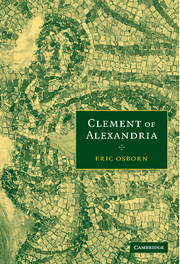Book contents
- Frontmatter
- Contents
- Preface
- List of abbreviations
- 1 Life and works
- PART I DIVINE PLAN/ECONOMY
- PART II DIVINE RECIPROCITY
- PART III FAITH AND SALVATION
- Conclusion
- Appendix: Irenaeus and Clement
- Select Bibliography
- Subject index
- Citations from Clement
- Citations from the Bible
- Citations from ancient authors
Conclusion
Published online by Cambridge University Press: 06 July 2010
- Frontmatter
- Contents
- Preface
- List of abbreviations
- 1 Life and works
- PART I DIVINE PLAN/ECONOMY
- PART II DIVINE RECIPROCITY
- PART III FAITH AND SALVATION
- Conclusion
- Appendix: Irenaeus and Clement
- Select Bibliography
- Subject index
- Citations from Clement
- Citations from the Bible
- Citations from ancient authors
Summary
CLEMENT REACHES HIS GOAL
Irenaeus and Clement deal with similar problems. They both begin from the God who is universal, spiritual and omnipresent. Their next concern is the divine economy, or history of salvation. Then follow the climax of history and the apex of the universe as it is found in Christ, who sums all things up. Their final questions are again the same, as they ask how humans participate in the new dispensation inaugurated by Christ, what it is like and how it will end. Here, however, their method is quite different. For Irenaeus there is still a narrative eschatology, a story of how man becomes God by a series of final events. Clement has very little final mythology. He is concerned to describe how the new humanity can be found now. Irenaeus declares in striking words that the glory of God is man fully alive. Only Clement gives us an extended account of that new humanity. Irenaeus tells us that God became man that man might become God; Clement alone gives us detailed description of the man who is a god walking about on earth. For this reason, Clement's description of the true gnostic, sage, or complete Christian is the end-point of his thought. Here the divine glory is to be seen, here the final episode of salvation is described as man participates in God. Clement claims to be inventing nothing, but simply bringing together what the scriptures say about the new humanity which is in Christ.
- Type
- Chapter
- Information
- Clement of Alexandria , pp. 269 - 281Publisher: Cambridge University PressPrint publication year: 2005



